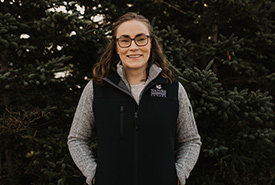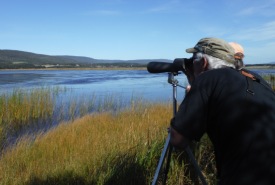Forces for nature: Celebrating International Women’s Day (part one)

Megan Lafferty (Photo by Victoria Snelgrove)
In celebration of International Women’s Day (March 8), we are profiling a few friendly female faces from across the country. These women contribute to the Nature Conservancy of Canada's (NCC's) mission and our work in different ways.
Megan Lafferty is NCC’s Newfoundland and Labrador program director. She interned with NCC in 2013 (read about her experience here) and has continued to work for NCC since. Megan studied forensic science before pursuing a master’s of environmental science at Memorial University. Over the years, she has led a number of projects, planning and carrying out NCC land conservation activities, coordinating land purchases and donations, and collaborating with partner organizations.
Related content
Read my interview with Megan below:
Wendy Ho (WH): What is most gratifying about your job?
Megan Lafferty (ML): One of the most gratifying aspects of my job is knowing that the work I do today will have a long-lasting impact. Natural spaces are important for so many reasons, such as biodiversity conservation, climate change resilience and human well-being. I feel lucky to be part of conserving some the best natural spaces that Canada has to offer.
WH: A part of your role involves engaging with the community and navigating partnerships. How do you engage with audiences that are less involved with conservation in areas where you work?
ML: In any area where NCC works, people are part of the overall conservation picture, even if they are not directly involved. Each community that we engage with is different, so our first step is to learn about our neighbours and discuss common interests. In many cases, we find that we can work together to support one another’s ideas. For example, our nature reserves in the Codroy Valley and on Sandy Point were primarily established for conservation purposes, but they now support a tourism trail and preserve a historical Newfoundland community, respectively.
WH: Tell us about an NCC property or project that you love and why it matters to Canadians.

Birders at Conservation Volunteers event, Codroy Valley, NL (Photo by NCC)
ML: A project that I love is NCC’s work in the Codroy Valley area. The valley is a unique gem on the island of Newfoundland and one that so many people miss when driving across the island. With exceptional bird diversity, beautiful views of the long-range mountains, and sandy beaches and cliffs dropping down to the Atlantic Ocean, the area is truly breathtaking.
NCC is fortunate to have some wonderful partnerships in the valley, including with the local school and the Codroy Valley Area Development Association, who maintains the Wetland Interpretation Centre and a network of trails. The Grand Codroy Estuary plays a significant role in bird migration, so it matters not only to Canadians, but also to the global community. It is a Wetland of International Importance under the Ramsar Convention, and the larger Codroy Valley contains two Important Bird Areas. If you’re ever driving across Newfoundland, be sure to turn off the highway for a visit!
WH: What do you like to do in nature, on the job and for leisure?
ML: What don’t I like to do in nature? On the job, I like exploring our nature reserves. It’s a special feeling to be so familiar with an area that, even when bushwhacking, you recognize certain trees, rocks and wetlands. It’s like visiting an old friend. I also like opportunities to share our nature reserves with others, especially children.
My passion for the outdoors started with my parents and camp counsellors taking the time to show me all kinds of interesting facts and activities, and I love being able to spread that excitement. For leisure, I like doing almost any outdoor activity, but have a particular interest in canoeing, hiking, camping and skiing.


